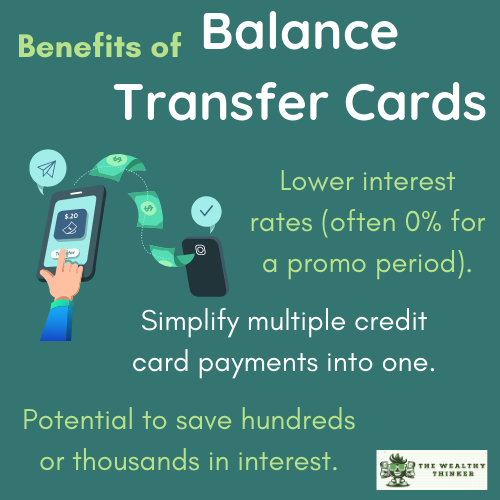Picture this: You’re staring at your credit card statement, watching the interest charges pile up faster than you can say, “minimum payment.”
Sound familiar?
If you’re nodding your head, it might be time to learn about the magic wand of the credit card world: the balance transfer card.
But what exactly are these financial wizards, and should you be reaching for one? Let’s dive in!

The ABCs of Balance Transfer Cards
In the simplest terms, a balance transfer card is a credit card that allows you to move your existing credit card debt onto it, usually with a lower interest rate.
It’s like having a friend offer to hold your heavy backpack for a while – suddenly, your load feels a lot lighter!
Here’s how it typically works:
- You apply for a balance transfer card
- If approved, you transfer your existing credit card balances to this new card
- You enjoy a lower interest rate (often 0%) for a promotional period
- You work on paying off your debt faster, thanks to the reduced interest
Sounds pretty sweet, right? But as with all things finance, it’s not quite as simple as waving a magic wand.
How Impactful Are Interest Rates When it Comes to Your Debt Repayment?
The Good, The Bad, and The Fine Print
Let’s break down the pros and cons of balance transfer cards:
The Good:
- Lower interest rates (often 0% for a promotional period)
- Potential to save hundreds or even thousands in interest
- Simplify multiple credit card payments into one
The Bad:
- Usually comes with a balance transfer fee (typically 3-5% of the transferred amount)
- The promotional rate doesn’t last forever
- You might be tempted to rack up new debt on your old cards
The Fine Print:
- You typically need a good to excellent credit score to qualify
- There’s usually a limit to how much you can transfer
- Some cards charge an annual fee
When a Balance Transfer Card Might Be Your Financial Superhero
So, should you consider getting a balance transfer card?
Here are some scenarios where it might make sense:
You’re Drowning in High-Interest Debt
If you’re paying double-digit interest rates on your credit cards, a balance transfer could be your lifeline. Even with the transfer fee, you could potentially save a bundle.
You Have a Plan to Pay Off Your Debt
Balance transfer cards work best when you have a solid plan to pay off your debt during the promotional period. If you can swing it, you could kiss your credit card debt goodbye for good!
You’re Juggling Multiple Card Payments
If keeping track of multiple due dates is giving you a headache, consolidating your debts onto one card can simplify your financial life.
Your Credit Score is in Good Shape
Remember, you typically need a good to excellent credit score to qualify for the best balance transfer offers. If your credit is solid, you might as well use it to your advantage!
When to Think Twice About Balance Transfer Cards
While balance transfer cards can be great tools, they’re not for everyone. Here are some situations where you might want to explore other options:
You Only Have a Small Balance
If your credit card debt is relatively small and you can pay it off in a few months, the balance transfer fee might outweigh the interest savings.
You’re a Chronic Overspender
If you have a habit of maxing out credit cards, a balance transfer card could be a dangerous temptation. You might end up with even more debt than you started with!
Your Credit Score Needs Work
If your credit score is on the lower side, you might not qualify for the best balance transfer offers. In this case, you might be better off focusing on improving your credit first.
You Can’t Pay Off the Balance During the Promotional Period
If you don’t think you can pay off the balance before the promotional rate expires, you might end up right back where you started – or worse.
Making the Most of Your Balance Transfer Card
If you decide a balance transfer card is right for you, here are some tips to maximize its benefits:
Do the Math
Calculate how much you’ll save in interest, factoring in the balance transfer fee. Make sure the savings are worth it.
Read the Fine Print
Understand all the terms and conditions, including what happens after the promotional period ends.
Make a Payoff Plan
Figure out how much you need to pay each month to clear your balance before the promotional rate expires.
Don’t Use the Card for New Purchases
Focus on paying down your transferred balance. New purchases might not have the same low interest rate.
Keep Your Old Cards Open
Closing old credit cards can hurt your credit score. Just cut them up or lock them away to avoid temptation.
Set Up Automatic Payments
This ensures you never miss a payment, which could result in losing your promotional rate.
The Balance Transfer Card: Final Thoughts
Balance transfer cards can be powerful tools for tackling credit card debt, but they’re not magic bullets. They work best when paired with a solid debt repayment plan and responsible spending habits.
If you’re serious about paying down your debt and have the discipline to stick to a repayment plan, a balance transfer card could save you a significant amount of money and help you become debt-free faster.
Remember, the goal isn’t just to move your debt around – it’s to pay it off for good.
So whether you decide to go for a balance transfer card or not, the most important thing is to have a plan to kick that debt to the curb once and for all.
Now, armed with this knowledge, you’re ready to make an informed decision about whether a balance transfer card is right for you.
Happy debt-busting!



















